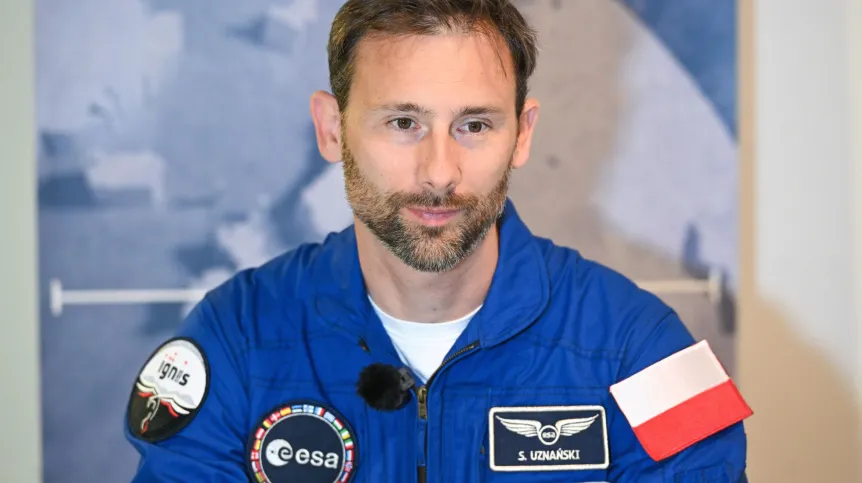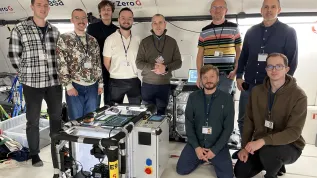
The launch of the Ax-4 mission with the Polish astronaut Sławosz Uznański-Wiśniewski to the International Space Station (ISS) will take place on May 29, Axiom Space announced last week. The astronauts will conduct research related to topics such as the impact of microgravity on the human body, Earth observation and fuels of the future.
Last week 's Axiom Space and the European Space Agency (ESA) press conference was devoted to scientific research to be carried out during the Ax-4 mission to the ISS. Over 60 experiments will be carried out in orbit, including those prepared in the US, India, Poland and Hungary (where the Ax-4 crew members come from) and other European countries, as well as Saudi Arabia, Brazil, Nigeria and the United Arab Emirates.
'We are opening the door to countries where, previously, access to space has been through the ISS partners, but we're opening the door to new countries, institutions and individuals that can bring new ideas that can really fuel an economy beyond Earth', Axiom Space Chief Scientist Lucie Low said during the conference.
Michael Roberts, Chief Scientific Officer of the International Space Station National Laboratory, reminded that over 4,000 experiments had already been conducted on the ISS.
As part of the Polish Ignis mission, 13 experiments will be conducted in orbit. They concern topics including medicine, biology, biotechnology and engineering.
Monika Banaszek-Cymerman, Head of the Research and Innovation Department at the Polish Space Agency (POLSA), mentioned 'Leopardiss' among the Polish experiments. It involves the use of a special processor that will enable the use of artificial intelligence on board satellites and in space missions. In turn, as part of the 'Space Volcanic Algae' experiment, scientists will test how microalgae, potential sources of food and oxygen, tolerate space conditions. The authors of the 'Neurofeedback EEG' study want to check how isolation and microgravity affect astronauts' stress levels.
'Our experiments are very unique and concern biotechnology, technology, material sciences, as well as a very important field, which is human physiology and psychology. The Ignis mission opens up space to everyone', Monika Banaszek-Cymerman emphasised.
She added that participation in the Ax-4 mission is a great opportunity for Poland: 'The results of Ax-4 can significantly increase our presence in missions on Earth and in the development of space. This can be directly translated into investments and benefits that we will achieve from an economic point of view'. She emphasised that it was also a 'historical moment' for Poland, which joined this mission to be present in orbit after 47 years.
Head of the Group for Microgravity Platforms and Research at the Indian Space Research Organisation, Tushar Phadnis, informed that the Indian experiments would concern, among other things, the development and genetic activity of microalgae and cyanobacteria, muscle regeneration in microgravity, and germination of edible plants in space.
JAccording to Chief Exploration Scientist at European Space Agency, Angelique Van Ombergen, it is particularly important to complement the ESA science team with specialists dealing with health research. She considers it a priority related to the strategy that assumes maintaining the crew in the best possible condition and fitness during all missions, as well as using this research to prepare for space exploration.
One of the experiments, for which the mission organisers have high hopes, is research on methods of treating insulin-dependent diabetes in microgravity conditions - a disease that has previously disqualified people from space flights. According to Chief Medical Officer at Burjeel Medical City (United Arab Emirates), Mohammad Fityan, researchers want to see how the body responds to microgravity, temperature changes and cosmic radiation and how these factors affect blood sugar metabolism.
Catriona Jamieson, director of the Sanford Stem Cell Institute at UC San Diego (USA), spoke about tests of a drug that prevents cancer cells from cloning. She explained that during the Ax-3 mission, researchers discovered that the drug kills cancers. This time, it will be tested on cancer cells from patients to see if it is equally effective in a wide range of cancers and if stem cells are stressed in space.
Balázs Nagy, R&D Director of the Hungarian to Orbit (HUNOR) programme, reported that the 25 Hungarian experiments in orbit would include research on the effects of space conditions on the human microbiome, the behaviour of low-melting-point metals in next-generation ion propulsion systems, and microfluidic chips for testing drugs in space.
Angelique Van Ombergen emphasised that ESA's plans extend far into the future. According th Van Ombergen, the current 'Explore 2040' strategy assumes conducting long-term research in lower Earth orbit, but we also going beyond it, flying to the Moon and eventually - to Mars.
Lucie Low pointed out that research that may seem simple and easy on Earth can be extremely complicated in space. That is why all partners and teams are aware that they have to translate what they do into actions that can be performed in a microgravity environment. Many analyses and conclusions regarding actual research results can only appear after returning to Earth. Lucie Low believes that all the research conducted as part of Ax-4 is exciting, but also very difficult.
Axiom Space announced that the launch of the Ax-4 mission is scheduled for May 29. The crew members are Peggy Whitson (USA) - commander; Sławosz Uznański-Wiśniewski (Poland/ESA) - specialist; Shubhanshu Shukla (India) - pilot and Tibor Kapu (Hungary) - specialist. The astronauts will spend 14 days on the ISS.
The Ax-4 mission will be a commercial manned expedition carried out by Axiom Space. The Polish astronaut's participation is the result of an agreement signed between the Polish Ministry of Development and Technology and ESA to prepare and conduct the Polish scientific and technological mission IGNIS to the ISS. As the executive agency of the Ministry of Development and Technology, the Polish Space Agency (POLSA) also takes part in the preparations.
Sławosz Uznański-Wiśniewski will be the second Pole in space. The first was Mirosław Hermaszewski (1941-2022), who flew on the Soyuz 30 spacecraft on June 27 - July 5, 1978, together with Piotr Klimuk (a Soviet cosmonaut of Belarusian nationality), During the 8-day mission, the astronauts completed 126 orbits of the Earth.
PAP - Science in Poland, Anna Bugajska (PAP)
abu/ bar/ jpn/













